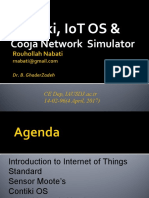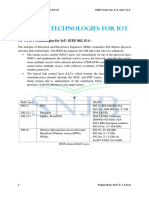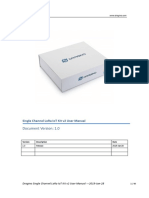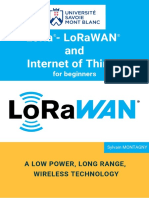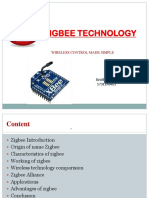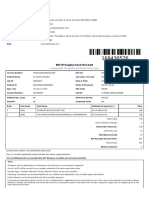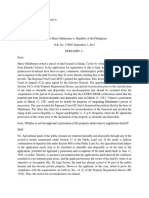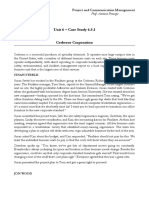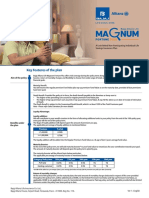Introduction to ZigBee Technology
Jiric Durias May 12, 2007
�My aim
To Your Interest In ZigBee
! ! ! k r a p s
May 12, 2007
�Outline
Introduction Architecture Device Types ZigBee Characteristics Traffic Types Network Model Technology Comparison ZigBee Application ZigBee Chips ZigBee Orgs
3
May 12, 2007
�A World of Remote Controls
safety entertainment
comfort lighting
May 12, 2007
security
�The ZigBee Home
From Popular Science Magazine
May 12, 2007
�Introduction
What is ZigBee?
is a low-power, short-distance wireless standard that has great possibilities in applications from home automation to industrial control. WPAN technology based on the IEEE 802.15.4 standard. created to satisfy the market's need for a cost-effective, standards-based wireless network that supports low data rates, low power consumption, security, and reliability. Key benefits of the 802.15.4 and ZigBee standards include extended battery life over current wireless standards, mesh and star network topologies, cost effectiveness, and no line of sight worries. This kind of network eliminates use of physical data buses like USB and Ethernet cables. To address this need, the ZigBee Alliance, an industry working group (http://www.zigbee.org/), is developing standardized application software on top of the IEEE 802.15.4 wireless standard.
May 12, 2007 6
�The 802 Wireless Space
WWAN IEEE 802.22 IEEE 802.20
Range
WMAN
WiMax IEEE 802.16 WiFi 802.11
WLAN
ZigBee 802.15.4 Bluetooth 802.15.1
WPAN 0.01
Slide Courtesy of
802.15.3 802.15.3a 802.15.3c 100 1000
0.1
1 10 Data Rate (Mbps)
May 12, 2007
�802.15.4 Application Space
Sensors and Controls
Home Automation Industrial Automation Remote Metering Automotive Networks Interactive Toys Active RFID/ asset tracking Medical
May 12, 2007
�ZigBee Key Features
Supports Star, Mesh and Cluster Tree networks. Mesh networking can extend the range of the network through routing, while self healing increases the reliability of the network by re-routing a message in case of a node failure Message acknowledgement helps to ensure that the data was delivered to its destination Multiple levels of security ensure that the network and data remain intact and secure. Has the potential to last as long as the shelf life of most batteries Supports 3 different frequency bands, providing customers the flexibility to choose what band best suites their needs.
May 12, 2007
�Why ZigBee?
Standards based Low cost Can be used globally Reliable and self healing Supports large number of nodes Simplicity
Easy to deploy
Very long battery life
extremely low power consumption the ability to sleep for a long time
Secure
May 12, 2007 10
�Why ZigBee is needed?
for wireless monitoring and remote control solutions for home automation, industrial automation, remote metering, automotives, medical equipment, patient monitoring, asset tracking systems, security systems, lighting and temperature control systems, and even toys. to tie an entire home, office or factory together for safety, security and control.
Thousands of sensors in a small space Wireless but wireless implies Low Power! and low power implies Limited Range.
May 12, 2007
11
�Architecture
Zigbee is build upon the foundations of IEEE 802.15.4 standard.
May 12, 2007 12
�The ZigBee Stack
Application Framework
ZPUI
Application Object 240
[On Endpoint 240] APSDE-SAP
APSSE-SAP NLSE-SAP
Application Object 1
[On Endpoint 1] APSDE-SAP
ZigBee Device Object (ZDO)
[On Endpoint 0] APSDE-SAP
APSME-SAP
Security Service Provider
Application Support (APS) Sub-Layer
NLDE-SAP
NLME-SAP
Network (NWK) Layer
MCPS-SAP MLME-SAP
Medium Access Layer (MAC) Layer
PD-SAP PLME-SAP
Slide Courtesy of
Physical (PHY) Layer
13
May 12, 2007
�Logical Device Types
ZigBee Coordinator (ZC)
One and only one required for each ZB network. Initiates network formation. May act as router once network is formed. Can perform an application too.
ZigBee Router (ZR)
May associate with ZC or with previously associated ZR.
Extends the network coverage
Manages local address allocation/de-allocation. Participates in multihop routing of messages. Looks after its ZEDs when it comes to broadcast and routing messages. Maintains Neighbor Table to allow Neighbor Routing. Sensors, actuators, monitors, switches, dimmers and other controllers Discovers and associates with ZC or ZR. Can be optimized for very low power consumption. Relies on its parent to let it sleep. Shall not allow association. Shall not participate in routing
14
ZigBee End Device (ZED)
May 12, 2007
�Physical Device Types
Full function device (FFD)
Can function in any topology Capable of being the Network coordinator Capable of being a coordinator Can talk to any other device (FFD/RFD) Generally line powered Limited to star topology Cannot become a network coordinator Talks only to a network coordinator (FFD) Very Simple implementation min RAM and ROM Generally battery powered
Reduced function device (RFD)
May 12, 2007
15
�Device Types
Physical device type distinguishes the device hardware complexity and capability
Logical device type distinguishes the physical devices deployed in a specific ZigBee network Coordinator (ZC)
Network establishment and control
Router (ZR)
Support data routing functionality. Can talk to other routers, coordinator, and end-devices
End device (ZED)
Can only talk to routers or the coordinator
Full Function Device (FDD): Adequate resources and memory capacity to handle all designated tasks. Reduced Function Device (RFD): Modest resources and memory capacity compared to FDD.
Yes
Yes
Yes
No
No
Yes
May 12, 2007
16
�ZigBee Characteristics
2.4GHz and 868/915 MHz dual PHY modes. This represents three license-free bands: 2.4-2.4835 GHz, 868-870 MHz and 902-928 MHz. The number of channels allotted to each frequency band is fixed at sixteen (numbered 11-26), one (numbered 0) and ten (numbered 1-10) respectively. The higher frequency band is applicable worldwide, and the lower band in the areas of North America, Europe, Australia and New Zealand . Maximum data rates allowed for each of these frequency bands are fixed as 250 kbps @2.4 GHz, 40 kbps @ 915 MHz, and 20 kbps @868 MHz. High throughput and low latency for low duty-cycle applications (<0.1%) Channel access using Carrier Sense Multiple Access with Collision Avoidance (CSMA - CA) Addressing space of up to 64 bit IEEE address devices, 65,535 networks
May 12, 2007
17
�ZigBee Characteristics Cont.
Low power consumption, with battery life ranging from months to years. In the ZigBee standard, longer battery life is achievable by either of two means: continuous network connection and slow but sure battery drain, or intermittent connection and even slower battery drain. 50m typical range Fully reliable hand-shaked data transfer protocol. Different topologies: star, cluster tree, mesh
May 12, 2007
18
�Topologies
Mesh
Star
Cluster Tree
Slide Courtesy of
PAN coordinator Full Function Device Reduced Function Device
May 12, 2007
19
�Traffic Types
ZigBee/IEEE 802.15.4 addresses three typical traffic types. IEEE 802.15.4 MAC can accommodate all the types. 1. Data is periodic. The application dictates the rate, and the sensor activates, checks for data and deactivates.
Application defined rate (e.g., sensors)
2. Data is intermittent. The application, or other stimulus, determines the rate, as in the case of say smoke detectors. The device needs to connect to the network only when communication is necessitated. This type enables optimum saving on energy.
Application/external stimulus defined rate (e.g., light switch)
3. Data is repetitive, and the rate is fixed a priori. Depending on allotted time slots, called GTS (guaranteed time slot), devices operate for fixed durations.
Allocation of time slots (e.g., mouse)
May 12, 2007
20
�ZigBee Channel Access Options
Beacon Mode
used when the coordinator runs on batteries enables all the clients to know when to communicate with each other has a coordinator that manages the channel and arranges the calls Significant value will be in system power consumption for networks which are primarily battery powered
Non-Beacon Mode
the coordinator is mains-powered
has its receiver on all the time and can therefore wait to hear from clients
devices are asleep' nearly always
The devices wake up and confirm their continued presence in the network at random intervals and goes back to sleep. The device wakes up instantly and communicates when an event occurs.
May 12, 2007
21
�Basic Network Characteristics
65,536 network (client) nodes Optimized for timing-critical applications and power management Time to Join Network: <30ms Sleeping to active: <15ms Channel access time: <15ms Full Mesh Networking Support
Slide Courtesy of
Network coordinator Full Function node Reduced Function node Communications flow Virtual links
May 12, 2007
22
�Network Model
The functions of the Coordinator, which usually remains in the receptive mode, encompass network set-up, beacon transmission, node management, storage of node information and message routing between nodes. The network node, however, is meant to save energy (and so sleeps' for long periods) and its functions include searching for network availability, data transfer, checks for pending data and queries for data from the coordinator.
ZigBee Coordinator (FFD) ZigBee Router (FFD) ZigBee End Device (RFD/FFD)
May 12, 2007
23
�Network Structure
Slide Courtesy of
May 12, 2007
24
�Network Structure
Slide Courtesy of
May 12, 2007
25
�Network Structure
Slide Courtesy of
May 12, 2007
26
�ZigBee Mesh Networking
Slide Courtesy of
May 12, 2007
27
�ZigBee Mesh Networking
Slide Courtesy of
May 12, 2007
28
�ZigBee Mesh Networking
Slide Courtesy of
May 12, 2007
29
�ZigBee Mesh Networking
Slide Courtesy of
May 12, 2007
30
�ZigBee Mesh Networking
Slide Courtesy of
May 12, 2007
31
�Technology Comparison
Standard Bandwidth Power Consumption 400+mA TX, standby 20mA 40mA TX, standby 0.2mA 30mA TX, standby 3#&956;A Protocol Stack Size 100+KB Stronghold Applications Internet browsing, PC networking, file transfers Wi-Fi Up to 54Mbps High data rate
Bluetooth
1Mbps
~100+KB
Interoperability, Wireless USB, cable replacement handset, headset Long battery life, low cost Remote control, battery-operated products, sensors
ZigBee
250kbps
4"32KB
In the last few years, new wireless local area networks (WLANs) such as Wi-Fi and Bluetooth became available. Table above shows the strengths and applications of these different systems. Wireless cameras for remote monitoring are an example of how to employ those technologies in home automation and control areas. But the problem is that those technologies don't satisfy the requirements for a HAN. If we take a look at the type of data that circulates within a network of sensors and actuators, we may find that most of it is small packets that control devices or obtain their status. For many applications, such as wireless smoke and CO2 detectors or wireless home security, the device mostly stays in deep-sleep mode and only sends a short burst of information if a trigger event occurs. The main requirements for devices in such types of networks are:
extremely low power consumption the ability to sleep for a long time simplicity low cost
A home network should also support different configurations, such as a star or mesh network, to effectively cover a household area of 30 to 70 meters.
May 12, 2007
32
�May 12, 2007
33
�ZigBee-enabled Device
A typical ZigBee-enabled device will consist of RF IC and 8-bit microprocessor with peripherals connected to an application sensor or actuators
May 12, 2007
34
�ZigBee Applications
security HVAC AMR lighting control access control TV VCR DVD/CD remote
BUILDING AUTOMATION
CONSUMER ELECTRONICS
patient monitoring fitness monitoring
ZigBee
PERSONAL HEALTH CARE
Wireless Control that Simply Works
PC & PERIPHERALS
mouse keyboard joystick
Slide Courtesy of
asset mgt process control environmental energy mgt
INDUSTRIAL CONTROL
RESIDENTIAL/ LIGHT COMMERCIAL CONTROL
security HVAC lighting control access control lawn & garden irrigation
May 12, 2007
35
�Application Example
Slide Courtesy of
May 12, 2007
36
�Home Awareness
Slide Courtesy of
May 12, 2007
37
�Advance Metering Platform with ZigBee
Slide Courtesy of
May 12, 2007
38
�Home Entertainment and Control
Slide Courtesy of
May 12, 2007
39
�The Ultimate ZigBee Home
Slide Courtesy of
May 12, 2007
40
�Commercial Lighting Control
Slide Courtesy of
May 12, 2007
41
�General Commercial Building Automation
Quick Payback Leads to Early Adoption
Obvious Uses
Lighting HVAC Alarm Systems Entry Systems Landscaping Leak Detection Pest Monitoring Humidity in Walls
Less Obvious Uses
Slide Courtesy of
May 12, 2007
42
�Patient Monitoring
May allow more patient freedom
Monitors vital statistics and sends via internet
Patient can remain in their own home Lowers cost and improves comfort
graphic
Allows monitoring of elderly family member
Sense movement or usage patterns in a home Notify via mobile phone when anomalies occur Can track behavior without visual spying Wireless panic buttons for falls or other problems Again lowers cost and improves patient lifestyle
Can be used in hospice care
Patients are allowed greater movement Reduced staff to patient ratio Light way to bathroom when they get out of bed
Reduces patient confusion
Slide Courtesy of
graphic
May 12, 2007
43
�ZigBee Alliance Promoters
May 12, 2007
44
�Participants
CompXs
May 12, 2007
45
�More Information
ZigBee Alliance Web Site http://www.ZigBee.org IEEE 802.15 Web Site http://www.ieee802.org/15
May 12, 2007
46
�Jiric B. Durias NCR Cebu Development, Inc. jiric.durias@ncr.com (63-32) 234-9150
jet_durias@yahoo.com +63 917-327-5869
May 12, 2007 47
�Thank You!
May 12, 2007
48




















